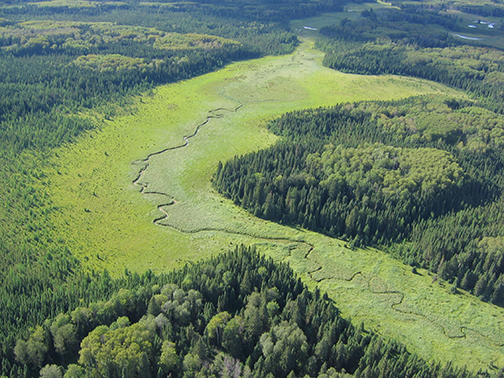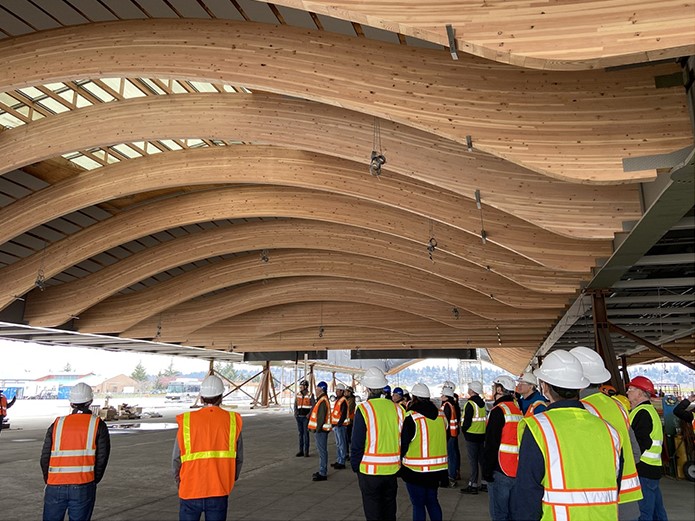By Lauren T. Cooper, SFI Chief Conservation Officer
There has been a great deal of dialogue recently about carbon and climate, leaving forest landowners asking themselves: “What does this mean for me? How do I make decisions with this information? How would I balance those management decisions with other goals, especially considering my trees and species type?”
At SFI, we help landowners take action to ensure they have robust forests in the future. Climate change threatens the forests of North America by changing the conditions in which trees thrive today. This creates uncertainty and is changing our understanding of what sustainable forestry means. Because of this, we are leading conversations with forest owners on how they can adapt their forests to continue to thrive. We work closely with experts and landowners to bridge the gap between research and the woodlot helping people who own forests to make good decisions.
 Forests sequester a lot of carbon. Indeed, the role of forests to pull pollutants out of the air and to emit oxygen is hard to overstate. There is more carbon stored within the SFI footprint than would be emitted by 30 billion gas-powered cars in a year. Carbon dioxide and other greenhouse gases act like a blanket: these gases trap heat that Earth would otherwise radiate out into space. Greenhouse gases, particularly carbon dioxide, play a crucial role in regulating our climate by trapping heat in the atmosphere, allowing us to thrive on planet Earth. However, as atmospheric carbon dioxide rates rise, more heat is retained, leading to an increase in global average temperatures and associated climate change impacts. The carbon that trees remove from the atmosphere allows for more heat from Earth to dissipate, keeping that warming and Earth’s system in balance. Therefore, healthy, thriving forests that pull carbon from the air are a big part of the solution to climate change.
Forests sequester a lot of carbon. Indeed, the role of forests to pull pollutants out of the air and to emit oxygen is hard to overstate. There is more carbon stored within the SFI footprint than would be emitted by 30 billion gas-powered cars in a year. Carbon dioxide and other greenhouse gases act like a blanket: these gases trap heat that Earth would otherwise radiate out into space. Greenhouse gases, particularly carbon dioxide, play a crucial role in regulating our climate by trapping heat in the atmosphere, allowing us to thrive on planet Earth. However, as atmospheric carbon dioxide rates rise, more heat is retained, leading to an increase in global average temperatures and associated climate change impacts. The carbon that trees remove from the atmosphere allows for more heat from Earth to dissipate, keeping that warming and Earth’s system in balance. Therefore, healthy, thriving forests that pull carbon from the air are a big part of the solution to climate change.
 Forests also form part of the solution to climate change as a source of sustainable materials, including growing innovation in the wood industry. Wood products store carbon for the lifecycle of the product and multiple studies demonstrate how the environmental impact of wood building products are low compared to other common building materials. Mass timber buildings are a part of this exciting trend that emphasizes carbon stored alongside the beauty and sustainability of wood. As an example, the new Portland Airport terminal will feature an immense timber roof – much of it sourced from Yakama Nation forests certified to the SFI Forest Management Standard). Wood can replace other more carbon-intensive materials for many uses, from clothing to kitchen utensils to packaging.
Forests also form part of the solution to climate change as a source of sustainable materials, including growing innovation in the wood industry. Wood products store carbon for the lifecycle of the product and multiple studies demonstrate how the environmental impact of wood building products are low compared to other common building materials. Mass timber buildings are a part of this exciting trend that emphasizes carbon stored alongside the beauty and sustainability of wood. As an example, the new Portland Airport terminal will feature an immense timber roof – much of it sourced from Yakama Nation forests certified to the SFI Forest Management Standard). Wood can replace other more carbon-intensive materials for many uses, from clothing to kitchen utensils to packaging.
Still, carbon is just one piece of information when it comes to your woodlot. Among the environmental and economic benefits of a healthy forest is its ability to absorb and store carbon in trees, soil, and biomass. Rather than just focus on carbon storage and sequestration, it is important to consider overall forest resilience and health. SFI certification takes a balanced approach to considering what healthy forests look like. As much as carbon sequestration can seem like a new value for forests, it is well-aligned with decades of good work on sustainability and on ensuring that we have forest regeneration.
SFI Leadership in Carbon Smart Forestry
Wood is a renewable resource and provides many benefits over other materials that contribute to greater pollution. Even so, that does not mean we can assume all harvested wood is part of the solution to climate change. This is where certification to Sustainable Forestry Initiative standards comes in. And in the last round of revisions of the SFI Forest Management Standard, we explicitly address this notion of climate smart forestry. By reducing emissions from forestry operations and thinking about forest health and climate resilience in the future, you can take steps as a landowner to make sure your forest is healthy and contributes to the solution to climate change.
The SFI Forest Management Standard’s Objective 9. Climate Smart Forestry, Performance Measure 9.1 requires SFI-certified organizations to ensure their forest management activities “identify and address the climate change risks to forests and forest operations and develop appropriate adaptation objectives and strategies” based on best scientific information.
Regeneration has been part of the SFI standards for a long time, along with other indicators of resilience in forest health. That said, climate change brings new challenges to regeneration, such as new stressors to certain species like heat, drought, pests, and invasive species. Drought and heat also bring an increased risk of fire, which affects all species and can result in recovery issues.
 In the Pacific Northwest, 7 million acres of forest in Washington, 1 million acres in Idaho, and 700,000 acres in Montana are certified to the SFI Forest Management Standard. To achieve SFI certification, forest operations must undergo independent audits to ensure that they meet the SFI 2022 Forest Management Standard requirements. Forests certified to the SFI standard must meet or exceed environmental conservation laws and regulations to protect water and wetlands, habitat, and biodiversity and conserve at-risk species of plants and animals to pass a third-party audit. SFI standards have the goal of improving the health of all the forests, whether natural or planted.
In the Pacific Northwest, 7 million acres of forest in Washington, 1 million acres in Idaho, and 700,000 acres in Montana are certified to the SFI Forest Management Standard. To achieve SFI certification, forest operations must undergo independent audits to ensure that they meet the SFI 2022 Forest Management Standard requirements. Forests certified to the SFI standard must meet or exceed environmental conservation laws and regulations to protect water and wetlands, habitat, and biodiversity and conserve at-risk species of plants and animals to pass a third-party audit. SFI standards have the goal of improving the health of all the forests, whether natural or planted.
The SFI 2022 Fiber Sourcing Standard is purposefully designed to influence millions of additional landowners through promotion, education, training, and outreach. This is accomplished in multiple ways, including addressing the conservation of biodiversity in harvests of purchased stumpage, and utilizing the services of qualified logging professionals, certified logging professionals, and resource professionals. SFI-certified organizations must also invest in forestry research, science and technology, and develop verifiable monitoring systems to evaluate the use of best management practices across the wood and fiber supply area. Further, the SFI Fiber Sourcing Standard requires certified organizations, with associations and partners, to broaden the awareness of climate change impacts on forests, wildlife, and biological diversity.
The SFI Fiber Sourcing Standard’s Performance Measure 5.3., requires SFI-certified organizations either “individually and/or through cooperative efforts involving SFI Implementation Committees, associations or other partners, broaden the awareness of climate change impacts on forests, wildlife, and biological diversity.”
Implementing Carbon Smart Forestry with SFI
At SFI, we have experience in providing tools and guidance to ensure certified organizations manage resilient forests. After SFI added climate-smart forestry to the SFI Forest Management Standard in 2022, we implemented a series of workshops across North America, including in the Pacific Northwest, to listen to forest owners and others in the sector: “What are the regional concerns of climate change adaptation? What are actions and decision-making around those concerns right now?” We partnered with Michigan State University to create a report that will be coming out in a few months, detailing how to approach these complicated climate change impacts and solutions and how to start thinking about it in a regional way in relation to each specific forest type.
Some climate-smart solutions are straightforward, though potentially costly, such as replacement of culverts to allow increase water flow. Other solutions could involve substantial changes in the way we manage forests. For example, because individual species could be more vulnerable to threats such as pests, pathogens, or fire in the future, some forest managers are exploring increasing species diversity in as a climate resilience strategy. Climate change necessitates that we make space for new thinking across the forest management spectrum – from old growth forests to more intensive forest management.
 In June, hundreds of professionals in the forest sector gathered in Atlanta for the 2024 SFI Annual Conference. I led a panel discussion titled Closing the Gap: Climate Science and Sustainable Forest Management. I shared the stage with a research scientist, a forest sector executive, and a leader from a federal agency. We discussed how insightful management can enhance the forests’ potential to sequester and store carbon. SFI certification and the SFI network are advancing these practical discussions and linking solutions directly with the standards.
In June, hundreds of professionals in the forest sector gathered in Atlanta for the 2024 SFI Annual Conference. I led a panel discussion titled Closing the Gap: Climate Science and Sustainable Forest Management. I shared the stage with a research scientist, a forest sector executive, and a leader from a federal agency. We discussed how insightful management can enhance the forests’ potential to sequester and store carbon. SFI certification and the SFI network are advancing these practical discussions and linking solutions directly with the standards.
The panel offered creative ideas landowners could implement to make their forests climate-smart and carbon-smart, including:
- Install larger culverts or bridges to withstand heavier rains and floods
- Change road design to reduce the chance that a flood will wash out the road
- Design roads to serve as fire breaks
- Consider alternative management interventions such as retention harvest, shelterwood, and large tree protection
- Change harvest schedule to avoid working in the forest during wet conditions, such as in spring
- Collaborate with Indigenous knowledge holders and land users about stewardship practices that may be helpful in a changing climate
- Assist trees migration, considering species that will thrive in the future climate conditions
At Michigan State University, I created the Forest Carbon and Climate Program to help people understand how trees store carbon and why forests are key players in fighting climate change, working with fellow conservation scientists to break down complex research into useful information for landowners. Now at SFI, I’m continuing this important work by supporting SFI-certified organizations, loggers, and forestry consultants to better understand and apply standards in their day-to-day operations. SFI standards are effective tools to support increasing carbon storage or sequestration, which is a desired management outcome.
New research continuously broadens our understanding of the impacts of climate change, so we must continuously innovate to find new ways to manage our forests so they may meet the challenges of the future. SFI is committed to interpreting the rapidly evolving science to support decision-making so that carbon storage and climate resilience can be considered alongside other forest values. SFI Standards provide a framework to increase the rigor with which we care for our forests. When we care for our forests with rigor, we optimize their potential to care for us in return.
A version of this article originally appeared in the Fall 2024 Edition of Northwest Woodlands Magazine.
